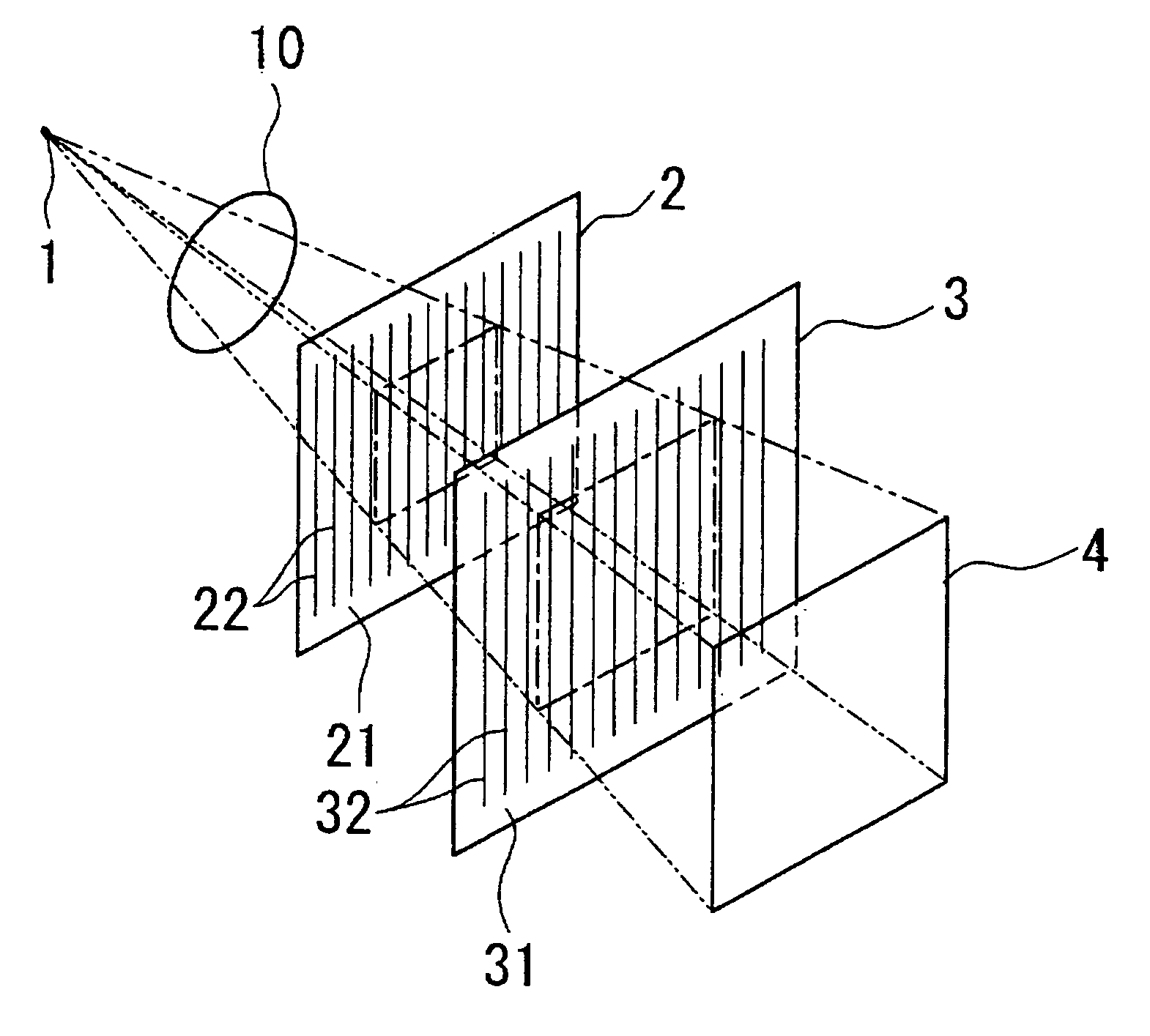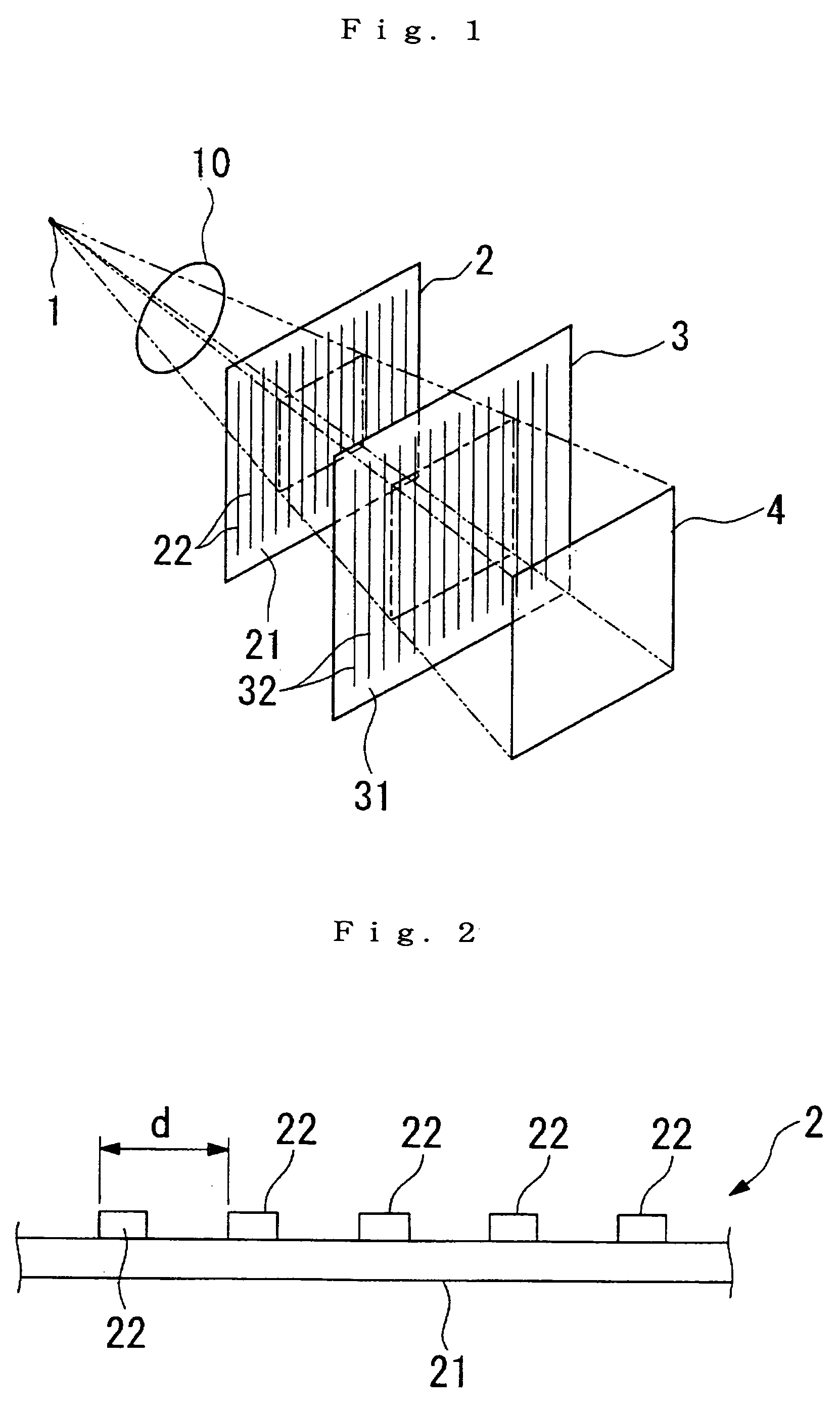X-ray imaging system and imaging method
a technology of x-ray imaging and imaging method, applied in the field of x-ray imaging apparatus, can solve problems such as complex configuration of the apparatus, and achieve the effect of simple construction
- Summary
- Abstract
- Description
- Claims
- Application Information
AI Technical Summary
Benefits of technology
Problems solved by technology
Method used
Image
Examples
experimental example 1
[0058]Experimental example 1 shows the occurrence of the Talbot effect due to irradiation of a diffraction grating with X-rays.
[0059]Experimental Conditions
[0060]X-rays used: light of wavelength 0.1 nm emitted by a synchrotron.
[0061]Diffraction grating: Gold pattern approximately 1 micron thick formed with a period d=8 microns on a 150 micron-thick glass plate.
[0062]The conditions for generating the Talbot effect using phase-type diffraction gratings are:
[0063]Z=(m+12)d2λ
[0064]Therefore, first, corresponding with when m=0, a self image of the diffraction grating should be formed when the distance Z from the first diffraction grating 2 to the detection surface is 32 cm. An X-ray image detector is then positioned at a position where the distance Z is 32 cm, and an image is recorded. The results is shown in FIG. 5. Similarly, when the distance Z is 64 cm, this situation is the most away from the above condition, and the self image is therefore unclear (FIG. 6). When the distance Z is...
experimental example 2
[0066]An experimental example 2 of the embodiment utilizing the X-ray Talbot effect is shown here.
[0067]Experimental Conditions
[0068]X-rays used: light of wavelength 0.1 nm emitted by a synchrotron.
[0069]Diffraction grating 2: Gold pattern approximately 1 micron thick formed with a period d=8 microns on a 150 micron-thick glass plate.
[0070]Diffraction grating 3: Gold pattern approximately 8 micron thick formed with a period d=8 microns on a 150 micron-thick glass plate.
[0071]Spacing Z1 of the diffraction gratings 2 and 3 is taken to be 32 cm for the Talbot effect to appear due to the diffraction grating 2. A plastic sphere approximately 1 mm in diameter is used as the test subject 10.
[0072]The test subject 10 is positioned between the X-ray source 1 and the first diffraction grating 2 just in front of the first diffraction grating 2.
[0073]X-rays emitted from the X-ray source are detected by the X-ray image detector arranged just behind the diffraction grating 3. As a result, it is p...
experimental example 3
[0079]Here, an experimental example of tomography is shown using the apparatus of this embodiment.
[0080]Experimental Conditions
[0081]The experimental conditions of experimental example 3 are the same as for experimental example 2.
[0082]The tomography employing this embodiment requires the following three procedures. Procedure 1 transforms X-ray images (hereinafter referred to as “moiré fringe images”) detected by the X-ray image detector 4 to “a distributed image of the X-ray deflection angle caused by refraction effects at the test subject 10” (hereafter referred to as a “phase shift differential image”). Procedure 2 acquires an image (hereinafter referred to as a “phase shift image”) mapping the shifts in phase by integrating the phase shift differential image. Procedure 3 reconstructs a three-dimensional image using tomography from phase shift images acquired in a plurality of photographing directions.
[0083]Procedure 1 employs a fringe scanning technique; that is one of diffracti...
PUM
| Property | Measurement | Unit |
|---|---|---|
| distance | aaaaa | aaaaa |
| distance | aaaaa | aaaaa |
| distance | aaaaa | aaaaa |
Abstract
Description
Claims
Application Information
 Login to View More
Login to View More - R&D
- Intellectual Property
- Life Sciences
- Materials
- Tech Scout
- Unparalleled Data Quality
- Higher Quality Content
- 60% Fewer Hallucinations
Browse by: Latest US Patents, China's latest patents, Technical Efficacy Thesaurus, Application Domain, Technology Topic, Popular Technical Reports.
© 2025 PatSnap. All rights reserved.Legal|Privacy policy|Modern Slavery Act Transparency Statement|Sitemap|About US| Contact US: help@patsnap.com



